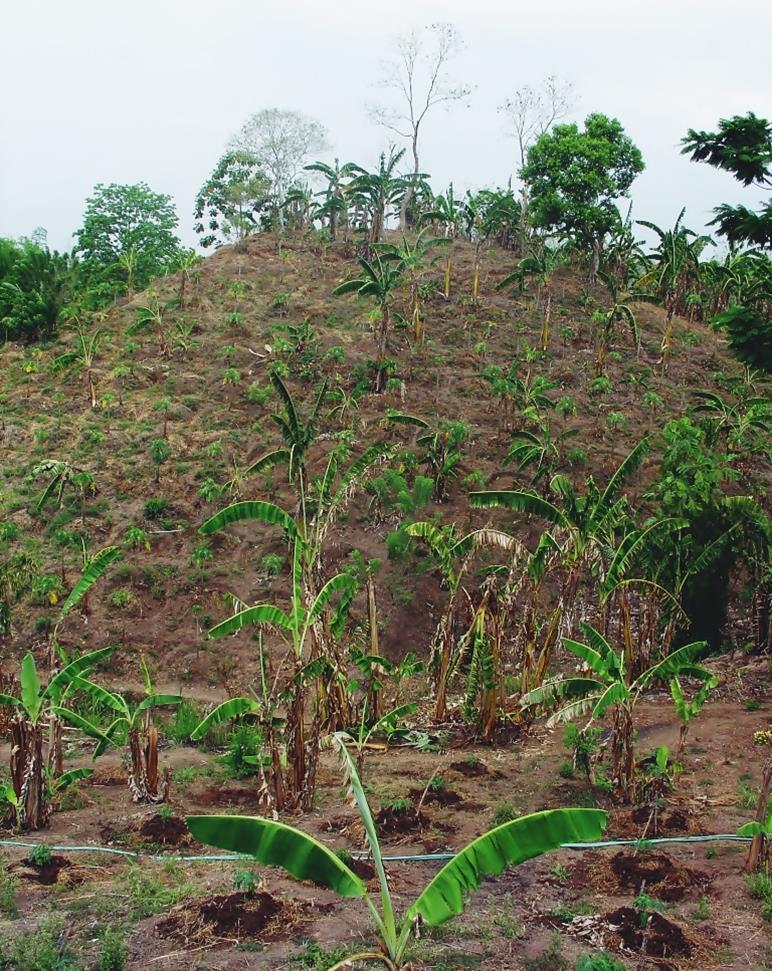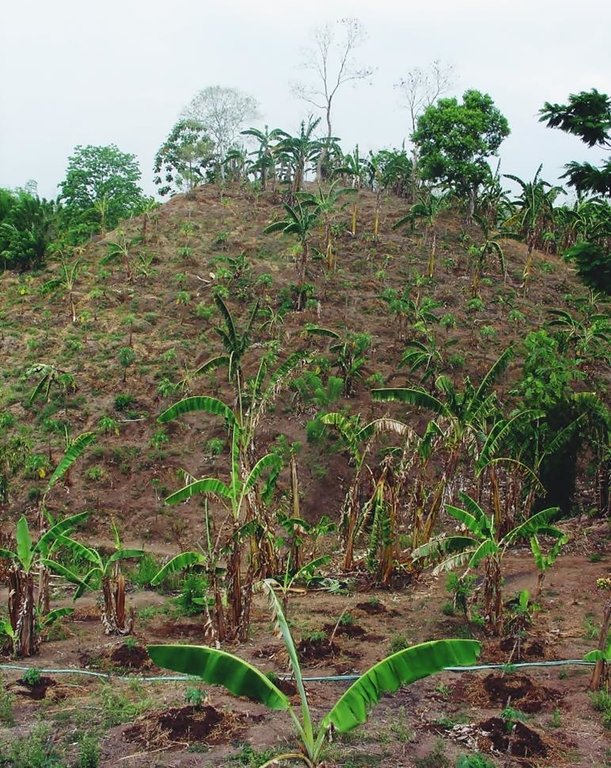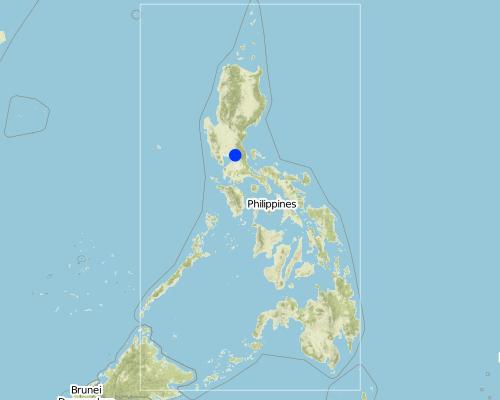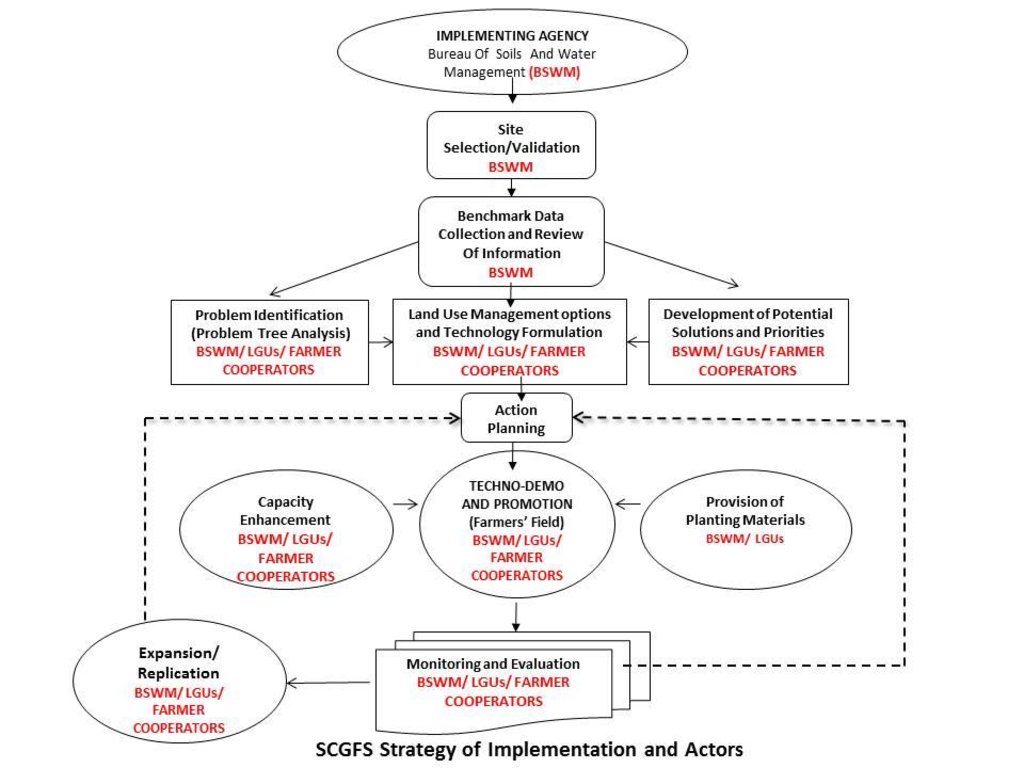Soil Conservation Guided Farm System [ฟิลิปปินส์]
- ผู้สร้างสรรค์:
- การอัพเดท:
- ผู้รวบรวม: Philippine Overview of Conservation Approaches and Technologies
- ผู้เรียบเรียง: –
- ผู้ตรวจสอบ: Deborah Niggli, Ursula Gaemperli
SCGFS, Guided Farm, Guided Farm Project
approaches_1973 - ฟิลิปปินส์
ดูส่วนย่อย
ขยายทั้งหมด ย่อทั้งหมด1. ข้อมูลทั่วไป
1.2 รายละเอียดที่ติดต่อได้ของผู้รวบรวมและองค์กรที่เกี่ยวข้องในการประเมินและการจัดเตรียมทำเอกสารของแนวทาง
ผู้เชี่ยวชาญ SLM:
ผู้เชี่ยวชาญ SLM:
ผู้เชี่ยวชาญ SLM:
Dacumos Evangeline
Bureau of Soils and Water Management
ฟิลิปปินส์
ผู้เชี่ยวชาญ SLM:
Creencia Rogelio
Bureau of Soils and Water Management
ฟิลิปปินส์
ผู้เชี่ยวชาญ SLM:
Raquid Jemar
Bureau of Soils and Water Management
ฟิลิปปินส์
ผู้เชี่ยวชาญ SLM:
Guillermo Josephroel
Bureau of Soils and Water Management
ฟิลิปปินส์
ชื่อของโครงการซึ่งอำนวยความสะดวกในการทำเอกสารหรือการประเมินแนวทาง (ถ้าเกี่ยวข้อง)
Decision Support for Mainstreaming and Scaling out Sustainable Land Management (GEF-FAO / DS-SLM)ชื่อของโครงการซึ่งอำนวยความสะดวกในการทำเอกสารหรือการประเมินแนวทาง (ถ้าเกี่ยวข้อง)
Department of Agriculture-Region VIII (DA-8) - ฟิลิปปินส์1.3 เงื่อนไขที่เกี่ยวข้องกับการใช้ข้อมูลที่ได้บันทึกไว้ผ่านทาง WOCAT
วันที่เก็บรวบรวมข้อมูล (ภาคสนาม):
29/06/2016
ผู้รวบรวมและวิทยากรหลักยอมรับเงื่อนไขเกี่ยวกับการใช้ข้อมูลที่ถูกบันทึกผ่านทาง WOCAT:
ใช่
1.4 การอ้างอิงถึงแบบสอบถามเรื่องเทคโนโลยี SLM
2. คำอธิบายของแนวทาง SLM
2.1 การอธิบายแบบสั้น ๆ ของแนวทาง
Soil Conservation Guided Farming System (SCGFS) is a land use management approach that integrates technologies: terracing, agro-pastoral technology, multi-storey cropping, and contouring within the socio-economic and bio-physical limitations of upland areas for optimum development of soil and water resource in a sustainable manner.
2.2 การอธิบายอย่างละเอียดของแนวทาง
การอธิบายอย่างละเอียดของแนวทาง:
Generally, SCGFS aims to promote sustainable land use management that provides agricultural livelihood while protecting and maintaining environmental sustainability in the upland areas of the country. Its specific objectives: (1) Establish community-based and farmer-managed techno demo farms cum learning centers on soil and water conservation in marginal uplands and watersheds of Small Scale Irrigation Projects (SSIPs); (2) Promote and disseminate effective soil and water conservation approaches and technologies for broader adoption; and (3) Develop a strong linkage and partnership among local stakeholders and cooperators to protect our upland resources and watersheds.
Participatory Approach amongst stakeholders as spearheaded by the Bureau of Soils and Water Management (BSWM) through the Soil Conservation and Management Division (SCMD)
Stages of implementation: (1) Coordination with the Local Government Units (LGU) and consultation with farmers; (2) Memorandum of Agreement (MOA) preparation; (3) Reconnaissance survey (a. Site selection/ identification b. Dialogue with farmer cooperators); (4) Field Survey/Ground Truthing (Topographic survey, Land Resources survey); (5) Maps Preparation( Topographic Map, Soil Map, Land Use Map, Slope Map and Erosion Map); (6) Preparation of preliminary Farm Development Plan; (7) Presentation of Farm Development Plan to the LGUs and Farmer Cooperators (Discussion, Revision/modification); (8). Preparation of Project Study Report (Final Farm Development Plan); (9) Institutional Development/ Capacity Building; (10) Implementation Stage / Farm Development; (11)Conduct of season long farmer field school; and (12) Monitoring and Evaluation including Operation and Maintenance.
Role of stakeholders: A. Bureau of Soils and Water Management (BSWM):
1. Provide the over-all direction in the preparation of plans and programs for the implementation of soil and water conservation through the SCGFS;
2. Provide technical support and assistance in the promotion and implementation of soil and water conservation and in the conduct of capacity building activities (i.e. in terms of training modules and resource persons);
B. Partner agencies/institutions (e.g. LGUs and other concerned agencies):
1. Prepare and endorse request to the BSWM for the establishment of SCGFS as demo farm of soil and water conservation technologies;
2. Provide technical support and assistance to the co-operators in the conduct of field survey and investigation, preparation of soil conservation farm plan, establishment of the SCGFS, and undertaking the necessary training activities;
3. In coordination with BSWM, assist the co-operators in availing necessary farm inputs and facilities for the establishment of the SCGFS; and
4. Undertake monitoring and assessment of operation and maintenance of established SCGFS to immediately address on-farm problems.
C. The Farmer Cooperators (i.e. interest groups/individuals):
1. Signify their interest to establish soil and water conservation demo farm through formal request to the BSWM;
2. Be willing to provide their own resources in the establishment of the demo farm;
3. Provide support and assistance to BSWM in the conduct of field survey and investigation;
4. Act as extension agents in the local community to disseminate soil and water conservation technologies with the demo farm as the community learning center.
2.3 รูปภาพของแนวทาง
2.5 ประเทศ ภูมิภาค หรือสถานที่ตั้งที่ได้นำแนวทางไปใช้
ประเทศ:
ฟิลิปปินส์
ภูมิภาค/รัฐ/จังหวัด: :
Bulacan
Map
×2.6 วันที่เริ่มต้นและสิ้นสุดของแนวทาง
ระบุปีที่เริ่ม:
2002
2.7 ประเภทของแนวทาง
- ใช้โครงงานหรือแผนงานเป็นฐาน
2.8 เป้าหมายหรือวัตถุประสงค์หลักของแนวทาง
SCGFS aims to promote sustainable land use management that provides agricultural livelihood while protecting and maintaining environmental sustainability in the upland areas of the country. Its specific objectives: (1) Establish community-based and farmer - managed techno demo farms cum learning centers on soil and water conservation in marginal uplands and watersheds of SSIPs; (2) Promote and disseminate effective soil and water conservation approaches and technologies for broader adoption; and (3) Develop a strong linkage and partnership among local stakeholders and cooperators to protect our upland resources and watersheds.
2.9 เงื่อนไขที่เอื้ออำนวยหรือเป็นอุปสรรคต่อการนำเทคโนโลยีภายใต้แนวทางนี้ไปปฏิบัติใช้
การมีไว้ให้หรือการเข้าถึงแหล่งการเงินและบริการ
- เอื้ออำนวย
Support from BSWM, Department of Agrarian Reform (DAR) & LGUs; Income Generating Technologies
การจัดตั้งระดับองค์กร
- เอื้ออำนวย
Organized farmers association
ความรู้เกี่ยวกับ SLM การเข้าถึงการสนับสนุนด้านเทคนิค
- เอื้ออำนวย
Capacity building, Farmers Field School
ปริมาณงานที่ทำได้ กำลังคนที่มีให้
- เอื้ออำนวย
Provide additional labor
3. การมีส่วนร่วมและบทบาทของผู้มีส่วนได้ส่วนเสียที่เกี่ยวข้อง
3.1 ผู้มีส่วนได้ส่วนเสียที่เกี่ยวข้องในแนวทางนี้และบทบาท
- ผู้ใช้ที่ดินระดับท้องถิ่นหรือชุมชนระดับท้องถิ่น
- ผู้เชี่ยวชาญ SLM หรือที่ปรึกษาการเกษตร
- รัฐบาลระดับท้องถิ่น
Local Government Unit
ถ้ามีผู้มีส่วนได้ส่วนเสียหลายคนที่เกี่ยวข้องให้ระบุหน่วยงานตัวแทน:
Land user groups
3.2 การเกี่ยวข้องของผู้ใช้ที่ดินระดับท้องถิ่นหรือชุมชนระดับท้องถิ่นในช่วงต่างๆของแนวทาง
| ความเกี่ยวข้องของผู้ใช้ที่ดินระดับท้องถิ่นหรือชุมชนระดับท้องถิ่น | ระบุผู้ที่มีส่วนเกี่ยวข้องและอธิบายกิจกรรม | |
|---|---|---|
| การริเริ่มหรือการจูงใจ | ไม่ลงมือ | BSWM initiates the establishment of the project. Field surveys i.e site validation, topographic surveys etc. are conducted by BSWM technical staffs. |
| การวางแผน | ปฏิสัมพันธ์ | Planning involves both BSWM and LGUs, technology/ies to be established is/are dependent on the biophysical limitation of the area and the needs of farmer cooperators. |
| การดำเนินการ | ปฏิสัมพันธ์ | Implementation of the project requires participatory involvement amongst stakeholders. |
| การติดตามตรวจสอบหรือการประเมินผล | ปฏิสัมพันธ์ | BSWM, LGUs and farmer cooperators are responsible in the monitoring and evaluation of the established technologies, these will ensure continued adaptation of the technology. |
3.3 แผนผังแสดงขั้นตอนการทำงาน (ถ้ามี)
3.4 การตัดสินใจเลือกใช้เทคโนโลยี SLM
ระบุผู้ที่ทำการตัดสินใจเลือกเทคโนโลยีมากกว่าหนึ่งวิธีไปปฏิบัติใช้:
- ผู้เชี่ยวชาญ SLM เป็นผู้ตัดสินใจหลัก ที่ติดตามให้คำปรึกษากับผู้ใช้ที่ดิน
4. การสนับสนุนด้านเทคนิค การสร้างขีดความสามารถ และการจัดการด้านความรู้
4.1 การสร้างขีดความสามารถ / การอบรม
ได้มีการจัดอบรมให้แก่ผู้ใช้ที่ดินหรือผู้มีส่วนได้ส่วนเสียคนอื่น ๆ หรือไม่:
ใช่
ให้ระบุว่าใครเป็นผู้ได้รับการอบรม:
- ผู้ใช้ที่ดิน
- เจ้าหน้าที่ภาคสนาม / ที่ปรึกษา
รูปแบบการอบรม:
- เกษตรกรกับเกษตรกร
- ใช้พื้นที่ทำการสาธิต
รูปแบบการอบรม:
- organization, capacity building
หัวข้อที่พูด:
Soil and Water Conservation Measures, Land Degradation, Soil Erosion Issues.
4.2 การบริการให้คำแนะนำ
ผู้ใช้ที่ดินมีการเข้าถึงการรับบริการให้คำปรึกษาหรือไม่:
ใช่
การอธิบาย/แสดงความคิดเห็น:
BSWM is the implementing agency. Advises are coming from the experts/ specialists of BSWM.
4.3 การเสริมความแข็งแกร่งให้กับสถาบัน (การพัฒนาองค์กร)
สถาบันได้รับการจัดตั้งขึ้นมาหรือเสริมความแข็งแกร่งโดยแนวทางนี้หรือไม่:
- ใช่ เล็กน้อย
ระบุระดับของสถาบันที่ได้รับการเสริมความแข็งแกร่งหรือจัดตั้งขึ้นมา:
- ท้องถิ่น
อธิบายถึงสถาบัน บทบาทและความรับผิดชอบ สมาชิก เป็นต้น:
Needy family heads
4.4 การติดตามตรวจสอบและประเมินผล
การติดตามตรวจสอบและประเมินผลเป็นส่วนหนึ่งของแนวทางหรือไม่:
ใช่
ถ้าตอบว่าใช่ แสดงว่าการจัดเตรียมเอกสารนี้มุ่งหวังที่จะเอาไปใช้สำหรับการติดตามตรวจสอบและประเมินผลใช่หรือไม่:
ไม่ใช่
4.5 การวิจัย
การวิจัยเป็นส่วนหนึ่งของแนวทางหรือไม่:
ไม่ใช่
5. การสนับสนุนด้านการเงินและวัสดุอุปกรณ์
5.1 ระบุงบประมาณประจำปีสำหรับแนวทาง SLM นี้
ถ้าหากว่างบประมาณประจำปีไม่เป็นที่ทราบแน่นอน ให้ระบุช่วงลงไป:
- 2,000-10,000
แสดงความคิดเห็น (แหล่งของการระดมทุน ผู้บริจาคคนสำคัญ):
Government (technical assistance i.e field surveys, provision of planting materials) 20%, local government (technical assistance, planting materials) 60%, local land users (labor, care and maintenance) 20%
5.2 การสนับสนุนด้านการเงิน / วัสดุอุปกรณ์ให้แก่ผู้ใช้ที่ดิน
ผู้ใช้ที่ดินได้รับการสนับสนุนด้านการเงิน / วัสดุอุปกรณ์ไปปฏิบัติใช้เทคโนโลยีหรือไม่:
ไม่ใช่
5.3 เงินสนับสนุนสำหรับปัจจัยนำเข้า (รวมถึงแรงงาน)
- อุปกรณ์
| ระบุปัจจัยนำเข้าที่ได้รับการสนับสนุน | เห็นด้วยระดับไหน | ระบุเงินสนับสนุน |
|---|---|---|
| เครื่องจักร | ได้รับการช่วยเหลือทางการเงินแบบเต็ม | |
- การเกษตร
| ระบุปัจจัยนำเข้าที่ได้รับการสนับสนุน | เห็นด้วยระดับไหน | ระบุเงินสนับสนุน |
|---|---|---|
| เมล็ด | ได้รับการช่วยเหลือทางการเงินแบบเต็ม | |
- โครงสร้างพื้นฐาน
| ระบุปัจจัยนำเข้าที่ได้รับการสนับสนุน | เห็นด้วยระดับไหน | ระบุเงินสนับสนุน |
|---|---|---|
| Greenhouse, Access Roads | ได้รับการช่วยเหลือทางการเงินแบบเต็ม | |
ถ้าแรงงานโดยผู้ใช้ที่ดินเป็นปัจจัยนำเข้าที่มีอยู่มากมาย ระบุด้วยว่าเนื่องจาก:
- สมัครใจ
5.4 เครดิต
มีการจัดหาเครดิตมาให้ภายใต้แนวทาง SLM หรือไม่:
ไม่ใช่
5.5 แรงจูงใจหรือเครื่องมืออื่น ๆ
แรงจูงใจหรือเครื่องมืออื่น ๆ ได้ถูกนำไปใช้ส่งเสริมการใช้เทคโนโลยี SLM หรือไม่:
ไม่ใช่
6. การวิเคราะห์ผลกระทบและการสรุป
6.1 ผลกระทบของแนวทาง
ช่วยให้ผู้ใช้ที่ดินนำเอาเทคโนโลยี SLMไปใช้และบำรุงรักษาสภาพไว้ได้หรือไม่:
- ไม่ใช่
- ใช่ เล็กน้อย
- ใช่ ปานกลาง
- ใช่ อย่างมาก
SCGFS involves the development of farming systems that adopts appropriate land uses, proper combination of crop and animal commodities, and the right mix of soil and water conservation practices. Thus, these measures ensures development in land use, livestock production and conservation measures.
ทำให้กลุ่มด้อยโอกาสมีอำนาจทางสังคมและเศรษฐกิจหรือไม่:
- ไม่ใช่
- ใช่ เล็กน้อย
- ใช่ ปานกลาง
- ใช่ อย่างมาก
The approach aids in income generation for needy family heads.
นำไปสู่ความมั่นคงด้านอาหารหรือปรับปรุงโภชนาการให้ดีขึ้น:
- ไม่ใช่
- ใช่ เล็กน้อย
- ใช่ ปานกลาง
- ใช่ อย่างมาก
Crop diversification helps needy farmers increase their income. Farmers who have undergone SLM training have more exposure to sustainable land use management that would help them improve and widen their knowledge in their farming activities.
Did other land users / projects adopt the Approach?
- ไม่ใช่
- ใช่ เล็กน้อย
- ใช่ ปานกลาง
- ใช่ อย่างมาก
Adjacent farms/ barangays and other sloping areas of the Philippines
Did the Approach lead to improved livelihoods / human well-being?
- ไม่ใช่
- ใช่ เล็กน้อย
- ใช่ ปานกลาง
- ใช่ อย่างมาก
Adaptors continue to rise, and with that more farmers generated more income, thus they were able to send their children to school and purchase properties.
6.2 แรงจูงใจหลักของผู้ใช้ที่ดินเพื่อที่จะนำ SLM ไปปฏิบัติใช้
- การผลิตที่เพิ่มขึ้น
One of the main purpose of the approach is to help farmers increase their production.
- จิตสำนึกด้านสิ่งแวดล้อม
Farmers will generate income while conserving the land.
- well-being and livelihoods improvement
6.3 ความยั่งยืนของกิจกรรมของแนวทาง
ผู้ใช้ที่ดินสามารถทำให้สิ่งต่างๆ ที่ได้ปฏิบัติใช้โดยแนวทางนี้ยั่งยืนได้หรือไม่ (โดยไม่มีการสนับสนุนจากภายนอก):
- ใช่
ถ้าตอบว่าใช่ ให้อธิบายว่าอย่างไร :
Technologies are already established and proven to be socially acceptable and economically viable. Farmer cooperators are equipped with technical knowledge they obtained from seminars and training provided by the approach. With these, it ensures sustainability of the project with farmer's own initiative.
6.4 จุดแข็งและข้อได้เปรียบของแนวทาง
| จุดแข็ง / ข้อได้เปรียบของแนวทางในทัศนคติของผู้ใช้ที่ดิน |
|---|
| New opportunities for other projects from government |
| Learning center for other barangays |
| Organization of farmers into cooperatives/associations |
| จุดแข็ง / ข้อได้เปรียบของแนวทางในทัศนคติของผู้รวบรวมหรือวิทยากรหลัก |
|---|
| Participatory/Interactive method |
| Serves as a learning center for other barangay or farmers |
| Easy to adapt |
| Multi-sectoral involvement |
| Transfer of technologies to farmer beneficiaries |
6.5 จุดอ่อน / ข้อเสียเปรียบของแนวทางและวิธีในการแก้ไข
| จุดอ่อน / ข้อเสียเปรียบในทัศนคติของผู้ใช้ที่ดิน | สามารถแก้ไขปัญหาได้อย่างไร |
|---|---|
| No major concern in the weaknesses / disadvantages of the approach. |
| จุดอ่อน / ข้อเสียเปรียบในทัศนคติของผู้รวบรวมหรือวิทยากรหลัก | สามารถแก้ไขปัญหาได้อย่างไร |
|---|---|
| Low budget for the establishment of techno-demo | Establish linkages with Local and International funding institutions; development of research proposals for possible funding. |
| Lack of research component particularly in economic and ecological analysis/assessment | Conduct on-site research studies; engage State/Universities and Colleges (SUCs) in research activity. |
7. การอ้างอิงและการเชื่อมต่อ
7.1 วิธีการหรือแหล่งข้อมูล
- ไปเยี่ยมชมภาคสนาม การสำรวจพื้นที่ภาคสนาม
- การสัมภาษณ์กับผู้ใช้ที่ดิน
7.2 การอ้างอิงถึงสิ่งตีพิมพ์
ชื่อเรื่อง ผู้เขียน ปี ISBN:
San Jose del Monte Soil Conservation Guided Farm Project: A success Story, Madrid Agribusiness Digest, 2012,pp 36
ช่องทางในการสืบค้น และราคา:
1.28 USD
ลิงก์และโมดูล
ขยายทั้งหมด ย่อทั้งหมดลิงก์
ไม่มีลิงก์
โมดูล
ไม่มีโมดูล






